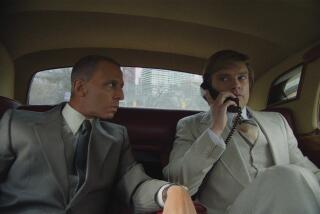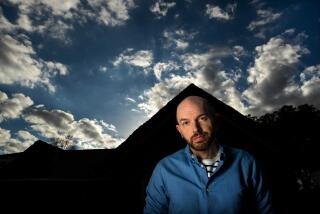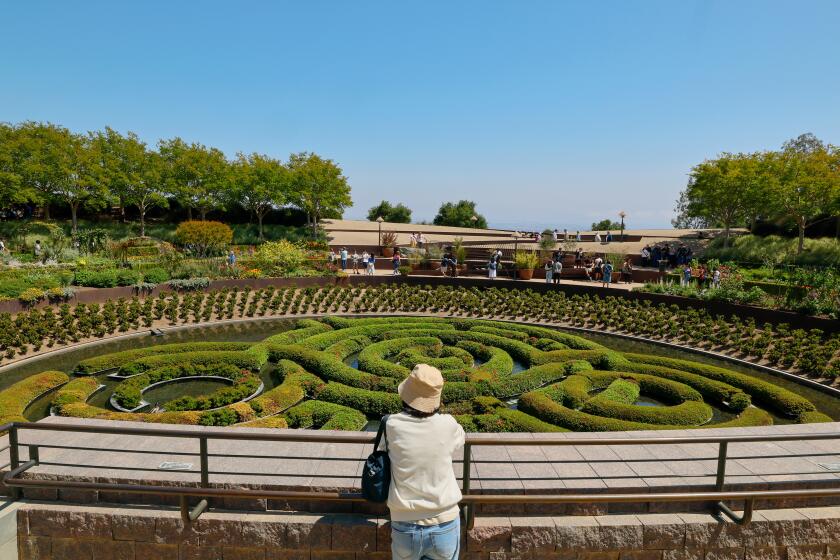Performing Arts : Indonesia’s Rebel Master : Javanese tradition meets the spirit of Martha Graham in the distinctive works of Bagong Kussudiardjo, who brushes off his many critic back home, vowing, ‘I believe we must go on.’
Though they were worlds apart geographically, their dance traditions separated by centuries, Javanese dance master Bagong Kussudiardjo, 66, says he and the late American modern dance pioneer Martha Graham share the same spirit.
In a recent interview in a conference room at the Indonesian Consulate in the Mid-Wilshire District, Kussudiardjo was flanked by two interpreters--as well as a phalanx of consulate representatives and publicists--as he talked about Graham, with whom he studied and toured in the late 1950s and early ‘60s on a Rockefeller Foundation scholarship.
But translation was hardly necessary when Kussudiardjo spoke about his connection with Graham--one expressive hand moved quickly and dramatically to his heart.
“Martha Graham’s spirit is what motivated me to learn modern dance,” Kussudiardjo said through his translators. “Martha Graham gave me support for my ideas, for my style. It is like a rebellion from traditional dance. . . . She was a very strong woman.”
Despite outrage from traditionalists in his own country, Kussudiardjo has fused modern and classical dance techniques with ancient Javanese dance traditions to create his own style. Audiences will be able to view the results in the first American performances of his Bagong Dance Theatre of Yogyakarta, Indonesia. The company will perform at the Alex Theatre in Glendale on Thursday and Friday.
The company consists of 20 dancers and the nine-member Bagong gamelan orchestra, whose musicians play 35 different handcrafted instruments. Kussudiardjo, who was in town to oversee the technical setup for the show, said the musicians will perform brand-new compositions for this concert.
Kussudiardjo said audiences should expect to see “a different side of Indonesia” through his choreography. “It is a new combination, it is more dynamic, it is just--different,” he said. “It is something new, something exciting.”
Kussudiardjo--looking part owl and part sage, dressed simply in black, with round silver wire-rimmed glasses matching his hair and beard--said with a laugh that traditionalists in Indonesia have tried many times to stop the show but have never succeeded. “I believe we must go on,” he said.
Although his work remains controversial in Indonesia, the choreographer has received numerous awards and distinctions, including the Medal of Honor from the government of Bangladesh, and has served as director of the Arts and Culture Mission of Indonesia.
One Krisnata, owner and president of San Diego-based Ibicom Inc., an importer of Indonesian periodicals that is producing the concerts, helped translate during the interview.
Said Krisnata: “In Java, they have a very ethnic tradition. (Kussudiardjo) wants to do dances not just for the Javanese people, but for all people, the whole of life itself--because that is what it means to him. That’s why he wants to be accepted by all the people not just Javanese people.” Krisnata added that his company is bringing the dancers here in honor of the 50th anniversary of Indonesian independence.
In recent years, Los Angeles audiences have been introduced to Javanese dance during the Los Angeles Festival, a multicultural summer arts festival that is an offshoot of the 1984 Olympic Arts Festival and has taken place every three years since then.
A centerpiece of the 1987 festival was Peter Brook and Jean-Claude Carriere’s version of the Indian epic “The Mahabharata,” which took more than eight hours to perform (and that was an edited version). In the 1990 festival, which celebrated the arts of Pacific Rim countries, the “Court Art of Java” dance company gave several performances, including a seven-hour all-night performance of wayang kulit , Javanese shadow puppetry, at the Los Angeles State and County Arboretum.
Kussudiardjo said audiences should expect a less formal style of dance than was presented in these traditional works. In all of his dances, he strives for simplicity, even in the costumes. And he added with a laugh that his dances will definitely be shorter. The first half of the performance will feature story dances of only five to seven minutes in length, revised and shortened by as much as one hour per story. And the second act will be an Indonesian-style “Mahabharata” that takes only 25 minutes.
“(American people) get bored,” Kussudiardjo explained. “It is hard for Americans to understand and digest the ideas.” When asked for his opinion on his current American surroundings--Hollywood--Kussudiardjo reacted as though he had been asked his opinion of some amusing but relatively useless toy. “It is interesting,” he observed. “I understand that people here need it. They need it--so be it.”
Kussudiardjo said his choreography is inspired not only by Graham but also by Javanese meditation techniques taught him by his grandfather. His mission, he said, is to “seek honesty and truth.”
At 17, Kussudiardjo began to study the traditions of Javanese, Sundanese, Balinese and Sumatran dance. He also studied painting. The self-described Abstract Expressionist has had exhibitions in Paris; Madrid; Bonn; Caracas, Venezuela, and other cities around the world. He said his painting is often based on the movements of shadow-puppet dance.
While the dynamism of American modern dance plays a role in his work, so does a more contemplative approach, Kussudiardjo said.
“ My style, even a 50-year-old man can do it,” he offered. “I believe that dance is not only about movement.” He gestured at the various people seated around the room--who, save an occasional fidget, were not moving at all. “ This is dancing.”
Then, with a power of concentration appropriate to a master of meditation, Kussudiardjo launched into a few minutes of demonstrating the strong hand gestures that are typical of his work and resemble the concentrated, ritualistic movements of yoga or martial arts. Even in the unlikely setting of the conference room, his movements inspired silence and rapt attention.
As if awakening from a dream, Kussudiardjo suddenly stopped moving, smiled and went on with the conversation.
Vital Stats
Bagong Dance Theatre
Address: Alex Theatre, 216 N. Brand Blvd., Glendale.
Price: $15.50-$32.50.
Dates: Thursday-Friday, 8 p.m.
Phone: (800) 233-3123.
More to Read
The biggest entertainment stories
Get our big stories about Hollywood, film, television, music, arts, culture and more right in your inbox as soon as they publish.
You may occasionally receive promotional content from the Los Angeles Times.






